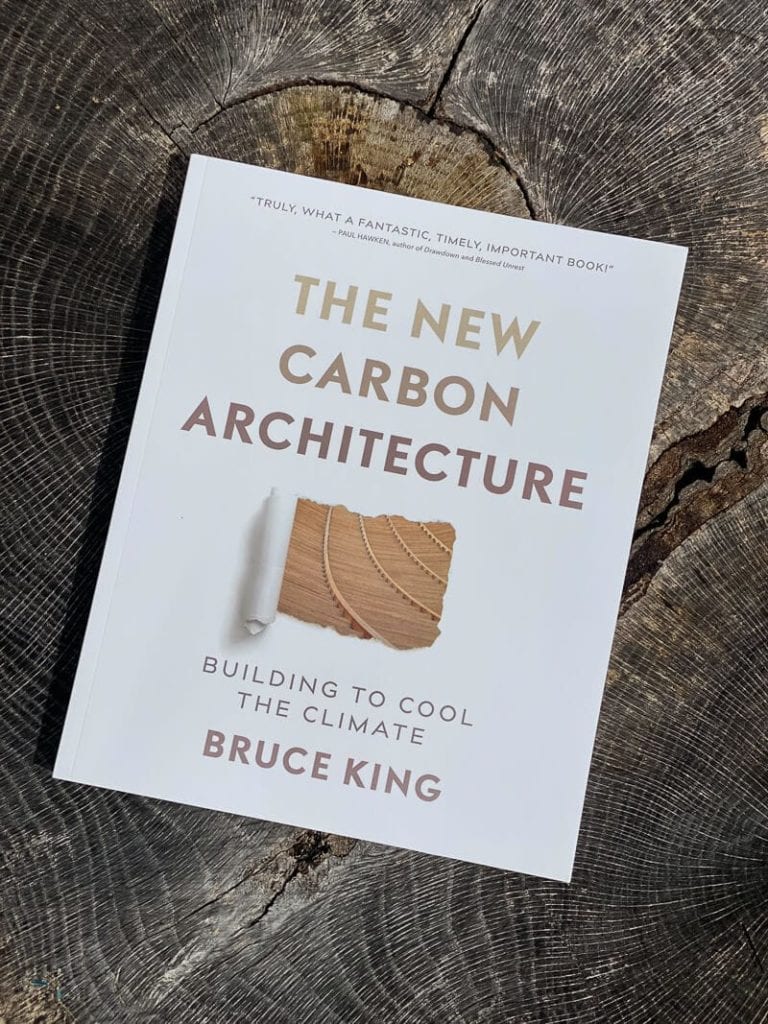
Architecture that heals the planet? Buildings that pull carbon out of the sky?
Can buildings be part of the climate solution? Bruce King thinks so, and shows us how we can soak up carbon from the atmosphere as we create beautiful buildings that showcase nature’s palette. The New Carbon Architecture: Building to Cool the Climate offers an inspiring approach to shaping our built environment as it seeks to answer a relatively complex question: How can we transform our buildings from climate villains into climate champions?
It is apparent that the author cares deeply about sustainable development, and hopes that we do too. But King does not moralize to us, and readers will enjoy his thoughtful and optimistic proposal for addressing climate change by converting carbon emissions into carbon storage. And it’s also an approachable book: a quick read that provides solutions-based approaches, with a ‘we can do it together’ spirit, because after all, this book is a collaborative project, one that seeks and provides the expertise of many leaders in the field.
Without a doubt, this is a very timely and important book for the building industry– for at least two very good reasons. One, we must cut carbon emissions or face irreversible consequences, and two, “constructing and operating buildings accounts for nearly half of all US energy consumption and fossil fuel emissions”. The good news is that we are already doing a better job of reducing the carbon emissions associated with operating our buildings. We’ve made and will continue to make steady progress in energy efficiency for the operation of our buildings, but King argues that we need to take a holistic approach here as we count carbon, and that our definition of a carbon-neutral building could use some updating. So, what might we be overlooking?

First, King lays out the facts. He explains that the embodied energy used in the construction process – the carbon emissions resulting from manufacturing and transporting building products, coupled with the construction process – is usually being ignored in the green building community, though very soon these will represent over 50% of the carbon emissions produced in the life-cycle of a building. Therefore, our big opportunity as architects, engineers and builders is to address how we can achieve a truly carbon-free building environment by setting our sights on a real NetZero standard. Yes, we need to face the fact that our standard of green building is not nearly as green as we think it is.
But we can do it – King posits that by taking a little inspiration from nature, we can use what’s already available to us in our natural environment to employ carbon-sequestering practices as we design our buildings; we can have everything and the carbon sink.

So, how do we get there? First, King explains that we can make smart substitutions and replacements to our current materials palette– instead of using concrete and steel, use wood. Instead of spray-foam insultation, consider using bonded plant fiber insulation systems. We can further develop low-carbon concrete alternatives, and we can even use the plastic in our oceans to make building blocks! King provokes our thinking by asking us to consider natural materials, and inspires us to apply our amazing human minds to creatively re-consider the materials we currently use to construct our buildings. Can we use natural clay concrete instead of Portland cement? Have we forgotten that innumerable building projects in our human past – such as the Great Wall of China and the Pantheon- were built with forms of clay concrete?
In chapter four, King offers perhaps his most compelling argument – that we can achieve a real NetZero standard in embodied energy by designing and building mid-rise buildings with wood – and specifically, by using mass timber construction. And there’s no need to wait, we can start doing this right away. And why should this be cause for celebration? Because typical timber captures 742 kilograms of atmospheric CO2 per cubic meter, whereas concrete emits 410 kg per cubic meter. Moreover, wood is one of the only renewable building resources while concrete and steel are not, though Jason Grant’s essay reminds us that in order to reap the full benefits of carbon-sequestration, we must also demand wood from sustainably harvested and certified forestry.

The mass timber solution offers a new way to build large and tall wood buildings – up to 20 stories – ostensibly providing the global building sector with a realistic path to meeting the COP21 (2015 United Nations Climate Change Conference) targets of carbon-free by the year 2050.
What else can we do? We can renovate existing buildings – instead of building new, because far less energy is required to renovate than to build new. We can use agricultural byproducts in construction, such as straw. And we can take a closer look at the health benefits of using natural materials while building beautiful spaces.
Above all, The New Carbon Architecture should be seen as a collaborative effort, of international scope, that provides an open forum for an evolving exploration of sustainable development. While this book is geared towards inspiring change in the construction industry, it is equally significant for those of us who wish to learn more about the relationship between our built environment and climate change. Can we have a win-win situation for the planet and our built environment? After reading King’s book, we think so.
(More about the author: Bruce King is a structural engineer and the founder and director of the Ecological Building Network (EBNet), an organization dedicated to developing and promoting low-carbon buildings. We met him when he presented at a Timber Framer’s Guild conference.)